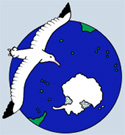| |
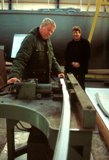
 Wandering Albatross is a semi-custom design by Dik Koopmans, a well known Dutch designer. Her first frame was bent in January 2002 at Beisterveld Jachtbouw in Holland.
It was a fantastic and emotional moment for us after years of saving and planning. We chose to build in steel for its strength, versatility and ease of repair and Holland, famous for the quality of its steel boats, was the obvious choice for the hull construction.
Wandering Albatross is a semi-custom design by Dik Koopmans, a well known Dutch designer. Her first frame was bent in January 2002 at Beisterveld Jachtbouw in Holland.
It was a fantastic and emotional moment for us after years of saving and planning. We chose to build in steel for its strength, versatility and ease of repair and Holland, famous for the quality of its steel boats, was the obvious choice for the hull construction.
|
| |
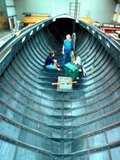
 Alexander Beisterveld is a true craftsman who works mostly alone, building one boat at a time - he personally cut and rolled every metal plate to shape. Although this was a slower process than in a shipyard (construction of the hull took 8 months),
we had the benefit of knowing that a highly experienced welder had joined every plate. It also meant we could be there for important and exciting moments – not as easy as it sounds as we were working in Florida at the time, flying back to Holland every 4 – 6 weeks to check on progress!
Alexander Beisterveld is a true craftsman who works mostly alone, building one boat at a time - he personally cut and rolled every metal plate to shape. Although this was a slower process than in a shipyard (construction of the hull took 8 months),
we had the benefit of knowing that a highly experienced welder had joined every plate. It also meant we could be there for important and exciting moments – not as easy as it sounds as we were working in Florida at the time, flying back to Holland every 4 – 6 weeks to check on progress!
|
| |
 With plans to voyage in high latitudes where we will encounter ice and heavy weather, we wanted a strong, fast, blue–water passage maker and Wandering Albatross is just that. We incorporated extra plate thickness below the waterline (5mm instead of 4mm) for additional strength, a watertight bulkhead quarter of the way back from the bow, a dedicated life raft locker in the cockpit and a doghouse for protection in bad conditions. She is 13m LOA, draws 2.25m, has a deep fin keel containing 5 tonnes of lead ballast, a skeg hung rudder and a beautiful, sleek profile.
With plans to voyage in high latitudes where we will encounter ice and heavy weather, we wanted a strong, fast, blue–water passage maker and Wandering Albatross is just that. We incorporated extra plate thickness below the waterline (5mm instead of 4mm) for additional strength, a watertight bulkhead quarter of the way back from the bow, a dedicated life raft locker in the cockpit and a doghouse for protection in bad conditions. She is 13m LOA, draws 2.25m, has a deep fin keel containing 5 tonnes of lead ballast, a skeg hung rudder and a beautiful, sleek profile.
|
| |
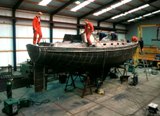 By the time Beisterveld had almost finished the construction, we had designed and ordered all our stainless steel grab rails, bolders (Dutch for cleats!), stanchions etc from TBS. One cold September day the team descended upon us like a swarm of worker bees and welded everything onto the deck – she was starting to look like a real boat!
By the time Beisterveld had almost finished the construction, we had designed and ordered all our stainless steel grab rails, bolders (Dutch for cleats!), stanchions etc from TBS. One cold September day the team descended upon us like a swarm of worker bees and welded everything onto the deck – she was starting to look like a real boat!
|
| |

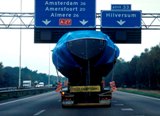 A few weeks later we returned to Holland to fit all the hatches, winches and tracks. The beauty of steel is that you can tap the thread straight
into the metal, something we became quite expert at as we drilled and tapped hundreds of holes for the mounting bolts! At last this phase of the build was over and it was time to move the hull to the painters shed. It was quite a day when we loaded her onto a truck and drove north to Makkum.
A few weeks later we returned to Holland to fit all the hatches, winches and tracks. The beauty of steel is that you can tap the thread straight
into the metal, something we became quite expert at as we drilled and tapped hundreds of holes for the mounting bolts! At last this phase of the build was over and it was time to move the hull to the painters shed. It was quite a day when we loaded her onto a truck and drove north to Makkum.
|
| |

 She was put into a warm, dry shed and over the next few months went through a metamorphosis, changing shades as the team of painters blasted, primed, faired and prepared her for the finish coats of Flag Blue and White, using an Awl Grip paint system.
She was put into a warm, dry shed and over the next few months went through a metamorphosis, changing shades as the team of painters blasted, primed, faired and prepared her for the finish coats of Flag Blue and White, using an Awl Grip paint system.
|
| |
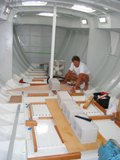 As we were still working in Florida, we made the huge decision to ship the finished hull across to the USA to build the interior and to rig her. While labour costs are higher in the States,
As we were still working in Florida, we made the huge decision to ship the finished hull across to the USA to build the interior and to rig her. While labour costs are higher in the States,  equipment and electronics are cheaper than in Europe and as we planned to do much of the installations ourselves, it made sense to have the boat near us.
Completely bare inside apart from the engine, she arrived in Ft. Lauderdale aboard the Dock Express in March 2003 and we wasted no time in getting to work on laying the cabin sole (floor) and putting in the bulkheads and ship–side cleating. This basic interior 'framework' had to be in place before we sprayed 2–3 inches of high density insulation foam over every bare surface.
equipment and electronics are cheaper than in Europe and as we planned to do much of the installations ourselves, it made sense to have the boat near us.
Completely bare inside apart from the engine, she arrived in Ft. Lauderdale aboard the Dock Express in March 2003 and we wasted no time in getting to work on laying the cabin sole (floor) and putting in the bulkheads and ship–side cleating. This basic interior 'framework' had to be in place before we sprayed 2–3 inches of high density insulation foam over every bare surface.
|
| |
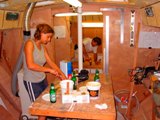
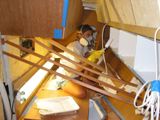 And so began 18 months of carpentry, painting and equipment installation. We worked with Lighthouse Shipwrights for much of this time, a great group of guys who not only made the project a success but were a lot of fun to work with.
Having contracted them to do the fine work that required skill and experience we took on the 'grunge'work.
Having designed the whole interior ourselves, we worked out the positions of seats, bunks, cupboards etc and helped make the patterns from which the teak veneered marine plywood was cut.
And so began 18 months of carpentry, painting and equipment installation. We worked with Lighthouse Shipwrights for much of this time, a great group of guys who not only made the project a success but were a lot of fun to work with.
Having contracted them to do the fine work that required skill and experience we took on the 'grunge'work.
Having designed the whole interior ourselves, we worked out the positions of seats, bunks, cupboards etc and helped make the patterns from which the teak veneered marine plywood was cut.

 Once fitted by the carpenters, we screwed, glued and epoxied it all together, often working long into the night to be ready for the next day.
We also painted all the lockers as we went along and coated every piece of marine ply with epoxy to protect it from moisture.
Once the woodwork was done we spent months varnishing before finally tackling the wiring, plumbing and electronics installations – amazingly enough it all seems to work! Once fitted by the carpenters, we screwed, glued and epoxied it all together, often working long into the night to be ready for the next day.
We also painted all the lockers as we went along and coated every piece of marine ply with epoxy to protect it from moisture.
Once the woodwork was done we spent months varnishing before finally tackling the wiring, plumbing and electronics installations – amazingly enough it all seems to work!
|
| |
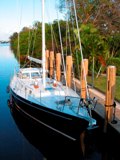
 Last but not least came the 55' mast, custom built by JSI in Florida and rigged by Andy Wall in Ft. Lauderdale using 10mm dyform wire.
With six new Dacron sails from Hood we were ready to test Wandering Albatross and she was everything we had dreamed of – powerful, fast and easy to handle.
We were ready to go at last and set out in December 2005 for a shake–down through the Caribbean and across the Atlantic to Scotland.
Last but not least came the 55' mast, custom built by JSI in Florida and rigged by Andy Wall in Ft. Lauderdale using 10mm dyform wire.
With six new Dacron sails from Hood we were ready to test Wandering Albatross and she was everything we had dreamed of – powerful, fast and easy to handle.
We were ready to go at last and set out in December 2005 for a shake–down through the Caribbean and across the Atlantic to Scotland.
|
